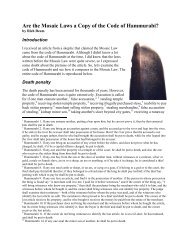Coming to Grips with the Early Church Fathers - Evidence for God ...
Coming to Grips with the Early Church Fathers - Evidence for God ...
Coming to Grips with the Early Church Fathers - Evidence for God ...
Create successful ePaper yourself
Turn your PDF publications into a flip-book with our unique Google optimized e-Paper software.
<strong>Coming</strong> <strong>to</strong> <strong>Grips</strong> <strong>with</strong> <strong>the</strong> <strong>Early</strong> <strong>Church</strong> Fa<strong>the</strong>rs’ Perspective on Genesis John Millam<br />
consequence, we would be better served by reexamining Genesis 1 in its original Hebrew ra<strong>the</strong>r<br />
than relying on <strong>the</strong> interpretation of <strong>the</strong> early church fa<strong>the</strong>rs.<br />
The creation week as a pattern <strong>for</strong> human his<strong>to</strong>ry is ano<strong>the</strong>r key example of typological<br />
(nonliteral) association that came <strong>to</strong> dominate <strong>the</strong> early church’s thinking about <strong>the</strong> age of <strong>the</strong><br />
earth.<br />
Patristics Were Young Earth Creationists?<br />
Since <strong>the</strong> church fa<strong>the</strong>rs were clearly divided on <strong>the</strong> interpretation of <strong>the</strong> days of creation, Mook<br />
shifts his focus <strong>to</strong> <strong>the</strong> age of <strong>the</strong> earth, where he can show that <strong>the</strong>re was widespread agreement<br />
among <strong>the</strong> church fa<strong>the</strong>rs that <strong>the</strong> earth is very young (less than 6,000 years old). Many of <strong>the</strong><br />
fa<strong>the</strong>rs, including allegorical interpreters, taught this specific view. (By my own research, none<br />
of <strong>the</strong> fa<strong>the</strong>rs taught an old earth. 30 ) Mook concludes, “Allegorical interpreters among <strong>the</strong> fa<strong>the</strong>rs<br />
were especially remarkable in resisting <strong>the</strong> old-earth <strong>the</strong>ories of <strong>the</strong>ir day.” 31 Mook sees this<br />
agreement between <strong>the</strong> allegorists and those he deems “literalists” as proof that <strong>the</strong> church was<br />
united in rejecting <strong>the</strong> idea that <strong>the</strong> earth is billions of years old. Taken <strong>to</strong>ge<strong>the</strong>r, Mook’s<br />
evidence seems <strong>to</strong> lend strong support <strong>for</strong> viewing <strong>the</strong> fa<strong>the</strong>rs as young-earth creationists.<br />
As if that is not enough, Mook <strong>the</strong>n plays his ultimate trump card: “Ano<strong>the</strong>r strong proof of <strong>the</strong><br />
young-earth creationism of <strong>the</strong> <strong>Church</strong> fa<strong>the</strong>rs is <strong>the</strong>ir sex/septa-millennial view that <strong>the</strong> earth<br />
was less than 6,000 years old.” 32 This refers <strong>to</strong> a popular belief among <strong>the</strong> fa<strong>the</strong>rs that Jesus<br />
Christ would set up his millennial kingdom on <strong>the</strong> six thousandth year after creation. 33 Those<br />
holding <strong>to</strong> this framework would have had <strong>to</strong> believe <strong>the</strong> world was less than 6,000 years old;<br />
hence, Mook’s claim that <strong>the</strong> patristic fa<strong>the</strong>rs were young-earth creationists. Surely, this is an<br />
open-and-shut case. Or is it?<br />
Creation-Week Pattern <strong>for</strong> Human His<strong>to</strong>ry<br />
What Mook names <strong>the</strong> sex/septa-millenary construct, I prefer <strong>to</strong> call <strong>the</strong> creation-week pattern<br />
<strong>for</strong> human his<strong>to</strong>ry. This view posits that <strong>the</strong> creation week of Genesis 1 serves as a template <strong>for</strong><br />
<strong>God</strong>’s plan <strong>for</strong> humanity. <strong>God</strong> created <strong>the</strong> world in six “days” (regardless of <strong>the</strong> nature of those<br />
“days”), so human his<strong>to</strong>ry would also span six “days,” each 1,000 years long, based on Psalm<br />
90:4 (“…a thousand years in your sight are like a day…”). 34 Taken <strong>to</strong>ge<strong>the</strong>r, all of post-creation<br />
30. Let me offer two minor caveats. First, Origen actually wrote that <strong>the</strong> “world is not yet ten thousand years old,<br />
but very much under that” (Against Celsus 1.19) but this statement can be unders<strong>to</strong>od as being consistent <strong>with</strong> a<br />
6,000-year framework. Second, Philo (a Jewish scholar not discussed by Mook) is unique in rejecting attempts<br />
<strong>to</strong> date <strong>the</strong> origin of <strong>the</strong> world (Questions and Answers on Genesis 1.1). While this leaves open <strong>the</strong> possibility<br />
that he would be open <strong>to</strong> an old-earth, <strong>the</strong>re is no actual evidence <strong>to</strong> suggest that he actually was. John Millam,<br />
“The Genesis Genealogies,” Reasons To Believe, accessed September 28, 2010,<br />
http://www.reasons.org/files/non-staff-papers/The-Genesis-Genealogies.pdf.<br />
31. James Mook, “The <strong>Church</strong> Fa<strong>the</strong>rs on Genesis, <strong>the</strong> Flood, and <strong>the</strong> Age of <strong>the</strong> Earth,” in Terry Mortenson and<br />
Thane H. Ury, eds., <strong>Coming</strong> <strong>to</strong> <strong>Grips</strong> <strong>with</strong> Genesis (Green Forest, AR: Masters Books, 2008), 32.<br />
32. Ibid., 39.<br />
33. Ibid., 38–48.<br />
34. Justin Martyr (Dialog <strong>with</strong> Trypho, A Jew 81) and Irenaeus (Against Heresies 5.23.2) are sometimes mistakenly<br />
cited as teaching long creation days on <strong>the</strong> basis of equating “day” <strong>with</strong> a thousand years. This is a common<br />
error and we see it, <strong>for</strong> example, in Hugh Ross, A Matter of Days (Colorado Springs, CO: NavPress, 2004), 43.<br />
A day as a thousand years was never applied <strong>to</strong> <strong>the</strong> creation days <strong>the</strong>mselves, only <strong>to</strong> post-creation his<strong>to</strong>ry.<br />
Page 11 <strong>Evidence</strong> <strong>for</strong> <strong>God</strong> from Science






